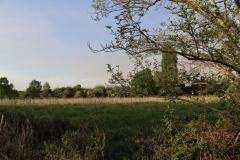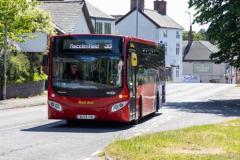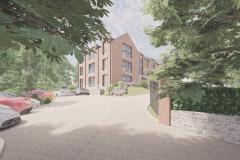Campaigners seeking to protect the green belt around Wilmslow from development believe that brownfield sites will provide the solution by supplying enough plots for the required number of new houses.
Consultation on the Draft Local Plan, which sets out the overall number of homes and jobs which will be required across the borough in the next 20 years, started this week and it was standing room only at Wilmslow Library on Wednesday evening when approximately 80 local residents turned out to hear more about Cheshire East's proposals for developing the town.
Adrian Fisher, Strategic Planning & Housing Manager at CEC, gave a talk about the Local Plan, proposals to build 400 new homes in Wilmslow by 2030 and develop 10 Ha of employment land in the area.
Two sites within the town have been identified for development. CEC is suggesting that land next to Royal London, which is currently in the green belt, will provide 75 new homes and 2 Ha of employment land. The Council is also actively exploring the possibility of extending the school's playing fields.
Additionally land to the west of Royal London will be removed from the green belt and designated as safeguarded land for future development, which means it would probably be first in the queue to be considered for development if there were additional requirements after 2030.
The second site, which is largely green field and outside of the green belt, is land at Adlington Road which had previously been safeguarded for development.
Adrian Fisher said "It has the capacity for up to 225 homes though I have to say if it was developed more in tune with its surroundings the numbers there would be rather less than that."
The draft plan also proposes that a new village is built in Handforth, on green belt land to the east of the A34, which will be an entirely self-contained community of 1800 homes with the provision for a further 500 homes to be built after 2030.
Speaking about the new settlement in Handforth, Adrian Fisher said "By having development here we can do it in such a way that we can get the facilities and overall it will be a better solution and will minimise the impact on the green belt.
"Clearly locally there will undeniably be considerable impact on green belt, it would be foolish to suggest otherwise, but rather perhaps that we put an impact in a concentrated way than perhaps scatter it far and wide."
He added "Importantly these housing figures would almost certainly need to be considerably higher (in Wilmslow) if we weren't creating a new settlement nearby and I think the benefits we see of the Handforth proposal is if we weren't doing that we would almost certainly be faced with nibbling away at the green belt in a lot of places and places where perhaps access isn't suitable, maybe the countryside people cherish near where they live and maybe the infrastructure isn't so good and the facilities may not be there."
Adrian Fisher continued "What we are trying to do is find a solution which will acceptable in terms of national guidance but still preserve the best of Wilmslow. We have a town of 20,000 population so to only suggest 20 new houses a year is a very very modest amount."
Representatives from Residents of Wilmslow (RoW) are opposed to these recommendations though and believe that there are enough brownfield sites in and around Wilmslow to provide the required 400 new homes - so there is no need to build on the green belt at Royal London or the safeguarded land Adlington Road.
They met with Cllr Michael Jones (Leader of CEC), Cllr David Brown (Deputy Leader of CEC) and Adrian Fisher (Strategic Planning & Housing Manager) on Tuesday, 15th January, to go through a list they have compiled of brownfield sites which they believe will more than meet the need for 400 houses in Wilmslow.
Speaking at Wednesday's public meeting Cllr Keith Purdom, of Wilmslow Town Council, said "One of the things, together with the residents of Wilmslow, we've achieved is to get you down from 1500 (as suggested in the draft Wilmslow Vision document) to 400.
"There is a strong body of opinion which suggests that the RoW group will be able to find brownfield sites upon which 800 houses could be built. If we could persuade you that there are indeed north of 400 brownfield sites on which houses could be built does that make any difference? Does that mean we can reduce numbers of these two sites or forget one or other of the sites, or both of them?"
Adrian Fisher responded "Potentially yes. We would of course before we get to this stage look to develop brownfield sites, the difficulty comes to find those numbers."
CEC has identified brownfield sites which they believe will accommodate 140 new homes in Wilmslow and has agreed to now take a look at the spreadsheet of suggested brownfield sites provided to them this week by RoW.
Speaking at the public meeting, Manuel Golding of RoW said "We have done a lot of work on brownfield because that's our salvation. We put before Adrian yesterday a list of brownfield sites which in our belief can accommodate around 820 homes. Now that could be flats, apartments and houses. They've promised they will go through that list and they will consult us.
"We have to find brownfield sites that will take 400 units and we need everybody in this room to be searching for these brownfield sites.
"Going back to the safeguarded site. RoW are committed to protecting every green field in Wilmslow but we can only do that if we get enough brownfield units."
Manuel added "The other things is employment, down the road from here there is Airport City which is going to employ up to 20,000 people, down the road from here there is another Manchester Airport complex near the M56 which is going to employ probably another 10,000 people. There is enough employment facilities and opportunities around this area for Wilmslow not have to be subjected to unnecessary employment facilities.
"Most people in this town, including myself, are used to travelling miles every day there and back. This is a residential town, this is not an industrial commercial town. It's commercial background is retail and the largest employer currently is said to be Royal London but it is not the largest employer I suspect of Wilmslow people and there is a big difference in that. Same with Waters down the road, that is going to employ a lot of people but the vast majority will not be living in Wilmslow, they are not Wilmslow people but the employment is there.
"Going back to the green field site at Adlington Road, if we find enough brownfield sites we want it protecting.
"Going back to Royal London we don't necessarily believe Royal London has the best interests of Wilmslow. It says it's a big employer it wants to build a hotel on the site, on these plans there's a hotel, it doesn't need employment facilities because it can't fill it's current units, Fulshaw Hall and Lloyd House are partially empty, they are looking for new tenants - why does it need another complex, to enhance the value of it's land?
"Across the road is site D, also owned by Royal London. I must say in fairness to Cheshire East that Michael Jones the Council Leader has assured us that that site will go in to green belt. But it is up to us all here to support that requirement so we all need to fill out your forms to make sure that site is protected.
"If you don't do anything the council has no alternative."
Adrian Fisher responded "The point is we have two difficulties, or challenges shall we say.
"The first is we have a development industry with a vested interest who will be looking very closely at what we do around Wilmslow and they will be seeking to argue we are not doing enough to develop. There is an imperative for growth and development, what are we doing in Wilmslow they will be saying. A town of 20,000 you are not doing enough they will argue.
"The other challenge is we have an inspector to persuade as well, who may well be asking the same questions. Saying you've got your fourth largest town in the borough, are you seriously suggesting that you're not going to propose any meaningful development over the next 20 years and so we have a dilemma. We have no desire at all to create more difficulties locally than is necessary but there is that tension we have to come up with something that is credible.
"If we can evidence the 400 homes, if we can clearly demonstrate they can be provided then that's great and then maybe one of these sites can fall out but at the time we prepared this plan in all honesty we hadn't got that evidence and therefore we would be negligent if we weren't going forward with proposals. They might not be the right proposals but that's the purpose of the consultation."
The consultation on the latest stage of the Cheshire East Local Plan runs until 26th February 2013. The relevant documents and comment forms are available on the Cheshire East website and paper copies of the comment form will be available from Wilmslow Library and Wilmslow Town Council.
RoW can be contacted by emailing Manuel Golding or David Lewis.








